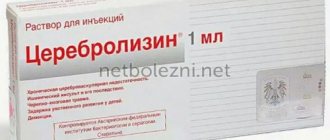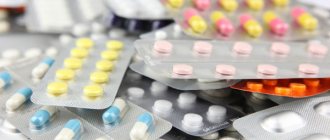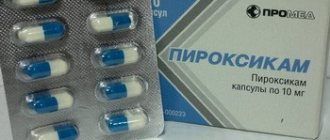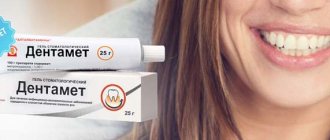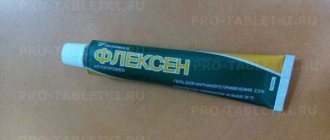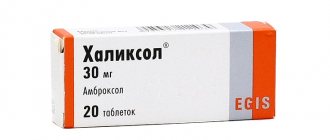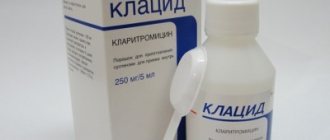Pharmacological authorities
Pharmacodynamics.
Nimid® is a non-steroidal anti-inflammatory drug of the methanesulfonanilide group, which exhibits anti-inflammatory, analgesic and antipyretic effects. The therapeutic effect of Nimidu is due to the fact that it interacts with the arachidonic acid cascade and reduces the biosynthesis of prostaglandins by inhibiting cyclooxygenase.
Pharmacokinetics.
In the human body, it is readily absorbed when taken orally, reaching maximum plasma concentrations after 2-3 years. Up to 97.5% of nimesulide is bound to plasma proteins. Nimesulide is actively metabolized in the liver via CYP2C9, the cytochrome P450 isoenzyme. The main metabolite is parahydroxy derivative, which also has pharmacological activity. The recovery period ranges from 3.2 to 6 years. It is not excreted from the body - approximately 50% of the dose taken. Approximately 29% of the administered dose is excreted in the metabolized form in the feces. Less than 1-3% is excreted from the body unchanged. The pharmacokinetic profile does not change in the summer age.
Drug interactions Nimid
Granules, tablets. When used simultaneously with warfarin and similar anticoagulants, acetylsalicylic acid, there is an increased risk of bleeding. The simultaneous use of Nimid and furosemide in the treatment of patients with impaired renal and cardiac function requires caution. NSAIDs reduce the clearance of lithium, which leads to an increase in its concentration in the blood plasma and its toxicity. Therefore, when using Nimid and lithium preparations simultaneously, it is necessary to carefully monitor the concentration of lithium in the blood plasma. With simultaneous use of nimesulide with digoxin, theophylline, glibenclamide, ranitidine, and antacids, no clinically significant interaction was observed. Nimid inhibits the action of the CYP 2C9 enzyme. Therefore, the plasma concentration of drugs that are affected by this enzyme may be increased when used simultaneously with Nimid. Caution should be exercised if Nimid is used less than 24 hours before or less than 24 hours after the use of methotrexate, since the plasma concentration of methotrexate and its toxicity increase. Increased nephrotoxicity of cyclosporines is possible when used simultaneously with Nimid. Gel. With the simultaneous local use of several NSAIDs, local irritation in the form of urticaria, skin redness, and peeling may develop. Glucocorticoids and antirheumatic drugs (gold preparations, aminoquinolones) enhance the anti-inflammatory effect of Nimid gel.
Contraindicated
Sensitivity to nimesulide or to any component of the drug is increased.
History of hyperergic reactions (bronchospasm, rhinitis, urticaria) to stagnation of acetylsalicylic acid or other non-steroidal anti-inflammatory drugs. History of hepatotoxic reactions to nimesulide.
Associated stagnation of other substances with potential hepatotoxicity.
Alcoholism and drug abuse.
There is a history of intestinal bleeding or perforation associated with the advanced stagnation of non-steroidal anti-inflammatory drugs.
Virus of the vulva or duodenum in the gastrointestinal phase, evidence of a history of infection, perforation or bleeding in the herbal tract.
A history of cerebrovascular hemorrhage or other hemorrhage, as well as illness that is accompanied by bleeding.
Severe damage to the throat of blood.
The severity of heart failure.
The serious damage to the function is no good.
Impaired liver function.
Illnesses with elevated body temperature and/or flu-like symptoms.
Children's age up to 12 years.
The third trimester of gestation and the period of breastfeeding.
Special instructions for the use of the drug Nimid
Granules, tablets. To reduce the risk of side effects, it is necessary to use the minimum effective dose of the drug, and the duration of the course of treatment is minimal. If patients taking the drug develop symptoms of liver damage (anorexia, nausea, vomiting, abdominal pain, fatigue, dark urine) or the results of liver function tests indicate liver damage, the drug should be discontinued. It is not recommended to prescribe Nimid to such patients. When treating with Nimid, it is recommended to avoid the simultaneous use of hepatotoxic drugs, analgesics, NSAIDs and alcohol consumption. Gastrointestinal bleeding or ulcer/perforation may occur at any time while using the drug, with or without symptoms, and with or without a history of gastrointestinal complications. If gastrointestinal bleeding or ulcers occur, the drug must be discontinued. Nimid is prescribed with caution to patients with a history of gastrointestinal pathology (ulcerative colitis or Crohn's disease), or to patients with renal or heart failure. If renal function deteriorates, the drug should be discontinued. Elderly patients are more likely to develop side effects, including gastrointestinal bleeding, perforation, dysfunction of the heart, kidneys and liver. Therefore, regular clinical monitoring of the patient’s condition is recommended. Nimesulide may interfere with platelet function in patients with hemorrhagic diathesis; therefore, it is used with caution and under constant monitoring. The use of NSAIDs may mask an increase in temperature due to a bacterial infection. If your body temperature rises or flu-like symptoms appear, you should stop taking the drug. Pregnancy and lactation Nimid is contraindicated in the third trimester of pregnancy. The use of nimesulide may interfere with fertility and is not recommended for women planning pregnancy. By suppressing the synthesis of prostaglandins, Nimid can cause premature closure of the ductus botalus, pulmonary hypertension, oliguria, and oligohydramnios. The risk of bleeding, weakness of labor and peripheral edema increases. Due to insufficient data on the use of the drug during pregnancy and the penetration of nimesulide into breast milk, the use of Nimid is contraindicated during breastfeeding and is not recommended in the first and second trimester of pregnancy. The ability to influence the control of vehicles and other mechanisms During treatment, care must be taken when driving vehicles. The gel is applied to intact areas of the skin, avoiding contact with open wounds and mucous membranes; it is also not recommended to use the gel with occlusive dressings. To reduce the risk of side effects, it is necessary to use the minimum effective dose with the shortest duration of treatment. If the patient's condition does not improve, it is necessary to conduct additional examination of the patient and adjustment of therapy. Period of pregnancy and lactation The use of the drug is possible only when the expected benefit to the mother outweighs the potential risk to the fetus. The ability to influence the control of vehicles and other mechanisms does not affect.
Interactions with other medicinal drugs and other types of interactions
Pharmacodynamic interactions.
Corticosteroids: there is an increased risk of infection in the herbal tract or bleeding.
Antiplatelet agents and selective serotonin secretion inhibitors (SSSRIs): the risk of bleeding in the herbal tract increases.
Anticoagulants: NSAIDs may be potentiated by anticoagulants such as warfarin or acetylsalicylic acid, so this combination is contraindicated in patients with severe coagulation disorders. Since such combination therapy cannot be eliminated, it is necessary to closely monitor the indicators of laryngeal blood.
Diuretics, inhibitors of angiotensin-transforming enzyme and antagonism of angiotensin II.
NSAIDs may reduce the effect of diuretics and other antihypertensive drugs. In some patients with impaired function (for example, in patients with fever or summer age patients), there is a heavy dose of ACE inhibitors, angiotensin II antagonists or glycosides, What can be done to suppress the cyclooxygenase system in order to avoid impairment of the function of nirog and the onset of acute nicotine deficiency, which, as a rule, is reverse These interactions should occur if the patient suffers from stagnation of Nimid® simultaneously with ACE inhibitors or angiotensin II antagonists. Be very careful with this combination, especially for summer age patients. Patients are responsible for removing sufficient quantity of radish, and the nirkov function must be carefully controlled after the beginning of the drying of such a combination. Nemesulide temporarily weakens the effect of furosemide so that sodium is eliminated and potassium is eliminated to a lesser extent, and also reduces the diuretic effect. The immediate use of furosemide and Nimid in patients due to impaired cardiac or cardiac function requires caution.
In healthy volunteers, nimesulide significantly reduces the effect of furosemide on sodium excretion and, to a lesser extent, on potassium excretion, and also reduces sechoginal effect. Acute administration of nimesulide and furosemide will result in a change (by approximately 20%) in the area under the concentration-hour curve (AUC) and a decrease in the cumulative excretion of furosemide without changing the nickel clearance of furosemide.
Pharmacokinetic interactions with other drugs.
There was information about those that NSAIDs change the clearance of lithium, which leads to an increased level of lithium in blood plasma and toxicity of lithium. If you are diagnosed with Nimid, you need to discontinue therapy with drugs, and then frequently monitor the level of blood plasma.
No clinically significant interactions with glibenclamide, theophylline, warfarin, digoxin, cimetidine and antacids (a combination of aluminum and magnesium hydroxide) in vivo
. Nimesulide inhibits the activity of the CYP2C9 enzyme. With one-hour stagnation of liquids, which are substrates of this enzyme, with Nimid, their concentration in blood plasma may increase. Caution is required when taking non-mesulide at least 24 years before or at least 24 years after taking methotrexate, as there may be a shift in the level of remaining blood syringation and an increase oh toxicity.
Through the infusion of narcotic prostaglandin inhibitors of synthetases, to which nimesulide is added, the nephrotoxicity of cyclosporines may increase.
Infusion of other drugs onto nimesulide.
In vitro follow-up
It was found that nimesulide interacts with tolbutamide, salicylic acid and valproic acid. Regardless of the fact that these interactions were observed in blood plasma, significant effects were not avoided during the process of clinical stasis of the drug.
Indications for use of the drug Nimid
Acute pain. Symptomatic treatment of osteoarthritis with pain. Primary dysmenorrhea. Locally for: - diseases of the musculoskeletal system of an inflammatory and degenerative nature, which are accompanied by pain and swelling, such as rheumatic and rheumatoid arthritis, gouty and psoriatic arthritis, ankylosing spondylitis (Bechterew's disease), Reiter's syndrome, osteoarthritis, bursitis, myositis, tendonitis, tenosynovitis, osteochondrosis with radicular syndrome, myalgia, neuralgia, sciatica, lumbago, as well as post-traumatic inflammation of soft tissues and the musculoskeletal system (damage and rupture of ligaments, sprains and bruises of muscles), pain caused by heavy physical exertion.
Features of good stagnation
Unnecessary side effects can be kept to a minimum by using the lowest effective dose for the shortest period of time necessary to control symptoms of illness.
If treatment is not effective (change in symptoms of illness), therapy with the drug should be followed.
During treatment with nimesulide, it is recommended to avoid the one-hour stagnation of hepatotoxic drugs, as well as avoid drinking alcohol. The use of non-steroidal anti-inflammatory agents may mask changes in body temperature associated with underlying bacterial infection. If there is an increase in body temperature or the appearance of flu-like symptoms in patients who are taking nimesulide, the drug must be discontinued.
There have been reports of serious reactions in the side of the liver during treatment with nimesulide, including death. We are sick in those who are aware of symptoms similar to those of liver disease, such as anorexia, boredom, vomiting, abdominal pain, increased nausea, dark color of the cuticles, or we are sick in those who have laboratory tests of their function. and the livers recover as normal after taking the drug . Repeated use of nimesulide is contraindicated for such patients. During treatment with Nimid, patients should avoid taking other analgesics. There is no evidence of concomitant stagnation of other NSAIDs, including selective cyclooxygenase-2 inhibitors.
We are sick because of the stasis of non-mesulide and in which flu-like symptoms have appeared as a result of the stasis.
In patients with summer age, the frequency of adverse reactions to NSAIDs is increased, especially with possible bleeding and perforation in the grass tract, which can be fatal.
Virus, bleeding or perforation in the grass tract can threaten the life of the patient, especially if there is information in the anamnesis about those that similar symptoms occurred in the patient during the stagnation of any other NSAIDs (without limitation). The risk of such occurrences increases with increasing doses of NSAIDs in patients who have a history of tract infection, especially characterized by bleeding or perforation, as well as in patients of summer age. Such illnesses should be treated with the lowest possible effective dose. For these patients, as well as for those who simultaneously take low doses of acetylsalicylic acid or other drugs that increase the risk of culprit folding on the side of the herbal tract, then consider the possibility of stagnation of the combined therapy with drugs containing drugs such as misoprostol or proton pump inhibitors.
Patients with toxic diseases of the herbal tract, especially patients of advanced age, should be informed about any non-essential symptoms that arise from the treatment of the herbal tract, especially bleeding. This is especially important at the cob stages of harvesting. Patients who are taking concomitant medications that can increase the risk of rashes or bleeding, such as corticosteroids, anticoagulants, selective inhibitors of serotonin secretion, antiplatelet agents (acetylsalicy lic acid), it is necessary to inform about the need to exercise caution when stagnating nimesulide.
If there is a problem in a patient who is treated with Nimid®, there is bleeding or infection in the herbal tract, treatment with the drug should be applied.
NSAIDs should be used with caution in patients with Crohn's disease or with a history of nonspecific viral colitis, since the use of nimesulides can lead to their worsening.
The immediate use of nimesulide with other medications, such as oral contraceptives, anticoagulants, antiplatelet agents, can cause acute Crohn's disease and other diseases of the herbal tract.
Ailments with arterial hypertension and/or cardiac failure in the anamnesis, as well as ailments with congestion in the body and stress due to stagnation of NSAIDs will require appropriate monitoring and consultation. and a doctor.
Clinical studies and epidemiological data provide evidence that NSAIDs, especially at high doses and during treatment, may lead to an insignificant risk of arterial thrombotic events. conditions, such as myocardial infarction and stroke. To exclude the risk of culpability of such phenomena when stagnant with nimesulide, these data are insufficient.
Patients with uncontrolled arterial hypertension, acute cardiac failure, established ischemic heart disease, peripheral arterial disease and/or cerebrovascular disease should take nimesulide. If I give a thorough assessment, I will. In the same way, before administering the drug, we suffer from factors that risk the development of cardiovascular diseases, for example, with arterial hypertension, hyperlipidemia, celiac diabetes, and chicken.
If you are ill from impaired neurological function or from heart failure, the drug should be prescribed with caution due to the possibility of impairment of cardiac function. Whenever I become sick, I need to take a bath.
For patients of the summer age, it is necessary to carry out careful precautions due to the possibility of bleeding and perforation of the grass tract, impaired function of the eyes, liver or heart. Remnants of nimesulide can affect the function of platelets, which should be used with caution in cases of hemorrhagic disease. However, nimesulide does not replace acetylsalicylic acid in the prevention of cardiovascular diseases.
There have been reports of rare episodes of severe skin reactions in chronic NSAIDs, which can be fatal, such as exfoliative dermatitis, Stevens-Johnson syndrome, toxic epidermal necrolysis. In most episodes, when these reactions occurred during the first month during the previously prescribed course of treatment, the risk of their occurrence in patients significantly increases. Nimid® must be discontinued if the first signs of skin rash, mucous membrane damage, or other allergic manifestations appear.
Additional speeches.
The drug eliminates lactose. If you have a known intolerance to certain drugs, consult your doctor before taking this medication.
Suspension during pregnancy or breastfeeding.
Inhibition of prostaglandin synthesis can have an adverse effect on vaginity and/or fetal development. Data obtained from epidemiological investigations allow us to draw conclusions about those that, in the early stages of pregnancy, the stagnation of drugs that inhibit prostaglandin synthesis may increase the risk of immediate abortion, and Fetal heart disease and gastroschisis. The absolute risk of development of anomalies of the cardiovascular system moved from less than 1% to approximately 1.5%. It is important that the risk increases with increasing dosage and the severity of stagnation.
You should not take nimesulide during the first and second trimester of pregnancy unless absolutely necessary. When taking the drug, women who are experiencing symptoms, or in the first and second trimesters of pregnancy, should take the lowest possible dose and the least possible discomfort of treatment.
In the third trimester of gestation, all inhibitors of prostaglandin synthesis can lead to development in the fetus:
- pneumocardial toxicity (with early closure of the arterial ducts and hypertension in the pulmonary artery system);
- dysfunctions of nirogine, which can progress to nicotine deficiency with the development of oligohydramnios.
In the mother and fetus at the end of pregnancy it is possible:
- increased bleeding time, antiaggregation effect, which may occur when even low doses of the drug are administered;
- suppression of the short-term activity of the uterus, which can lead to shutting down or extending the period of canopy.
Therefore, there are no contraindications for nimesulide in the third trimester of pregnancy.
As an NSAID that inhibits prostaglandin synthesis, nimesulide can cause premature closure of the ductus pubis, pulmonary hypertension, oliguria, and oligohydramnios. The risk of bleeding, weakness of sexual activity and peripheral swelling increases. There is news about nitric deficiency in babies whose mothers have been taken without medication due to pregnancy. Investigations on animals have led to the atypical reproductive toxicity of the drug, but there is no reliable data that the stagnation of nimesulide does not help the vaginal system. There is no potential risk for humans; therefore, the use of nimesulide in the first and second trimesters of gestation is not recommended. It is unknown whether nimesulide penetrates into breast milk, and its use is contraindicated during breastfeeding.
Nimesulide can impair the fertile function in women, so it is not recommended to be administered to women who are at risk of pregnancy. For women who cannot become pregnant or for women who are undergoing constant infertility, consider nutrition about the use of nimesulide. If the vaginess is established during the period of ingestion of nimesulide, the doctor may inform you about this.
This is due to the fluidity of the reaction during treatment with vehicles or other mechanisms.
No monitoring was carried out on the infusion of nimesulide into the body by motor transport or other mechanical means, but when patients were infused with nimesulide, they experienced headache, confusion and drowsiness, then it follows that Get comfortable with driving vehicles or other machinery.
Method of congestion and dosage
To minimize possible unwanted side effects, it is necessary to maintain the minimum effective dose for a short period of time. It is recommended to live after receiving hedgehogs.
The maximum cost of treatment with Nimid is 15 days.
Grown up.
1 sachet (100 mg) 2 times per dose.
Summer age patients.
No dose adjustment is required.
Children have been around since the age of 12.
No dose adjustment is required.
Patients with impaired nirofunction.
For patients with mild or moderate impairment of narcotic function (creatinine clearance 30-80 ml/year), no dosage adjustment is required, but for patients with severely impaired narcotic function (creatinine clearance < 30 ml/year) є contraindications before administration of Nimid.
Instead, dissolve the sachet before standing in 1 bottle of warm water and drink immediately.
Children.
Nimid® is contraindicated for children under 12 years of age.
pharmachologic effect
Nimid belongs to the group of methanesulfonaniles NSAIDs. In simple terms, it has antipyretic, analgesic and anti-inflammatory properties.
This effect is achieved by blocking the production of prostaglandins, which are formed in places of tissue damage.
The therapeutic effect is due to the fact that the drug interacts with the arachidonic acid cascade and reduces the biosynthesis of prostaglandins. Probably, not everyone understands these terms, so let’s put it all in simple words.
When tissue damage and inflammation occur, the human body begins to release special substances (prostaglandins) that act on pain receptors and also cause inflammation and an increase in temperature.
The active ingredients of the drug block the release of prostaglandins, thereby reducing sensitivity and relieving inflammation
Overdose
Symptoms of acute overdose of nonsteroidal drugs (NSAIDs) may include the following: apathy, drowsiness, fatigue, vomiting, pain in the epigastric region. These symptoms, as a rule, change with supportive therapy. It is possible to cause scutulo-intestinal hemorrhage, arterial hypertension, acute nicotine deficiency, suppressed breathing, coma, but such symptoms are rare. Anaphylactoid reactions have been reported when therapeutic doses of NSAIDs have been ingested and when they have been overdosed. There is no specific antidote. Treatment overdose is symptomatic and supportive. There is no data on the use of nimesulide for additional hemodialysis, but if we take into account the high degree of binding of nimesulide to plasma proteins (up to 97.5%), then it is unlikely that dialysis will be effective. If symptoms of overdose are evident or after taking a large dose of the drug for 4 years after taking it, patients may be prescribed: vomiting and/or taking activated vugill (60-100 g for adults), and/or taking ohm osmotic carrying agent. Forced diuresis, dilation of urine, hemodialysis and hemoperfusion may be ineffective due to the high degree of binding of nimesulide to blood plasma proteins. Monitor the functions of the stove and stove.
Analogs
There are quite a lot of analogues of this drug, but it is important to understand that not every one of them helps in the same way. "Nimid" can help with various diseases, while the analogues are only partially identical and it is not always possible to find an ideal replacement for each problem.
Nevertheless, consider these drugs:
- Butadion.
- Veral.
- Disklomek.
- Diclofen.
- Dimecin.
- Dolgit.
- Ibolgin.
- Ketoprofen.
- Klafen.
These are the main drugs that can be compared with Nimid. For a more detailed understanding of how to use the analogue, you must carefully read the instructions for each drug.
Side effects
On the side of the blood and lymphatic systems:
anemia, eosinophilia, thrombocytopenia, pancytopenia, purpura.
On the side of the immune system:
increased sensitivity, anaphylaxis.
Metabolic disorders:
hyperkalemia.
On the side of the psyche:
due to fear, nervousness, greedy dreams.
On the side of the nervous system:
confusion, headache, drowsiness, encephalopathy (Reye's syndrome).
From the side of the organs:
blur the vision, unravel the vision.
On the side of the hearing and hearing organs:
vertigo (confusion).
On the side of the cardiovascular system:
tachycardia, hemorrhage, weakness of arterial pressure, hot flashes, arterial hypertension, increased risk of arterial thrombotic complications, such as myocardial infarction or stroke, heart failure.
On the side of the dichotomy system:
buttocks, asthma, bronchospasm.
On the side of the grass tract:
diarrhea, nausea, vomiting, including blood vomiting, constipation, flatulence, gastritis, abdominal pain, dyspepsia, stomatitis, emptying of the black color, bleeding in the herbal tract, swelling and perforation of the duodenum/schut, hardened stake It’s both sick and sick Crown.
On the side of the hepatobiliary system:
hepatitis; Bliskavichny (fulminant) hepatitis, with fatal consequences, including diarrhea; cholestasis.
From the side of the skin:
itching, scalp viscera, hyperhidrosis, erythema, dermatitis, urticaria, angioedema, skin lesions, erythema multiforme, Stevens-Johnson syndrome, toxic epidermal necrolysis.
On the side of the thyroid system:
dysuria, hematuria, seborrhea obstruction, nitric deficiency, oliguria, interstitial nephritis.
Zagalni destruction:
swelling, weakness, asthenia, hypothermia.
Laboratory displays:
increase in the level of liver enzymes.
